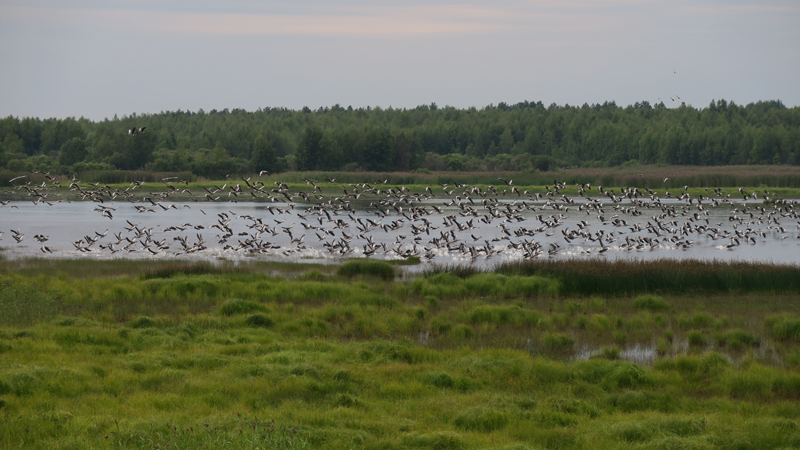Metsähallitus manages state-owned land and water areas, and hence, its role is increasingly important in safeguarding biodiversity. This is demonstrated by the assessment of threatened species that was published on Friday 8 March, as well as by the assessment of threatened habitats which was published at the end of last year. Metsähallitus intends to pay more attention to this issue by focusing on targeted conservation measures, promoting new forms of co-operation between different organisations, and developing new practices and ways to improve the status of species and their habitats.
Metsähallitus wants to further improve the status of species and habitats both in protected areas and areas designated for economic activity.
“The assessment of threatened species is very worrying. We take the findings very seriously,” says Pentti Hyttinen, Director General of Metsähallitus. “As the administrator of the state’s land and water areas, and as a body bringing together different goals and values, we have a good opportunity and a duty to make a difference. It is important that we make even better use of Metsähallitus’ expertise to improve the status of threatened species and habitats. Together with our partners we are also developing new practices and tools.”
Forest species’ habitats are being improved in multiple-use forests
Changes in forest habitats is one of the major reasons for the threatened status of many species. Metsähallitus invests over 40 million euros annually in biodiversity in state-owned multiple-use forests. In practice, this means that the most valuable areas for species are excluded from forestry management activities. Additionally, Metsähallitus will strengthen the protection of biodiversity with its new environmental guidelines.
“In order to increase dead wood, we save about 50,000 m3 of wood that was previously collected for energy production”, says Jussi Kumpula, Managing Director of Metsähallitus Metsätalous Oy.
As a result of Metsähallitus’ landscape-ecological planning, special regional features are taken into consideration, and ecologically valuable sites are excluded from forestry management activities. At the same time, the connectivity of these areas and the potential for the proliferation of species is safeguarded. An update on the ecological area network is in progress.
In addition, Metsähallitus will this year carry out an assessment of the need for active habitat restoration in forestry areas. Based on the assessment, decisions may be made for further action which may include eg. the removal of fish migration barriers, restoration of drained peatland ecosystems, or restoration of light-and-fire habitats.
Extensive co-operation is needed to safeguard the status of threatened species and habitats
“We are also looking for new practices to strengthen the populations of species dependent on natural forest habitats. As part of the Flying-squirrel LIFE project, we have started to develop forest management practices together with our broad partner network to improve the conditions of Flying squirrels’ habitats in state-owned multiple-use forests, as well as in private forests. As part of another LIFE project, we are starting to improve the habitat conditions of beetles that are dependent on dead trees. At the same time, many other endangered or threatened species will also benefit,” says Timo Tanninen, Director of Metsähallitus Parks and Wildlife Finland.
According to the assessment of threatened species, the second most common reason for the endangerment of species is the overgrowth of traditional agricultural habitats. Apart from forest species, the majority of endangered and threatened species live traditional agricultural landscapes, such as meadows and wooded pastures. Here, co-operation with farmers is important so that threatened traditional habitats and landscapes can be managed by grazing. It is essential to increase the areas of traditional agricultural landscapes by opening overgrown vegetation.
Good existing practices and new ones being developed
The assessment of threatened species also highlighted wetland bird species. The Hydrology-LIFE project, coordinated by Metsähallitus, improves the state of wetlands by developing new practices in a broad co-operation network of eg. nature organisations, representatives of hunting associations and the forestry sector.
“According to the assessment of threatened species, the populations of many wetland birds have collapsed. The need for active and continuous restoration of these areas is great. At the beginning of the 21st century, the Siikalahti wetland site in southern Karelia was restored, and the bird populations began to rise. When no resources for further restoration exist, the population numbers of many species have plummeted. Good practices developed during the projects must then become stable,” says Tuula Kurikka, Head of Nature Protection at Metsähallitus.
Collected data in better use
Assessments are based on data on species and habitats. Metsähallitus has a major role in collecting and managing such data. It is not only central to the above assessments, but it also helps to direct appropriate land and water use so that biodiversity protection and land and water use can be best coordinated.
One major goal is to make better use of The Finnish Inventory Programme for the Underwater Marine Environment (VELMU) data, both in conservation and responsible development of blue bio-economy and offshore wind power.
Further information:
Sustainable Development Manager Antti Otsamo, Metsähallitus Forestry Ltd, tel. 040 719 7734
Head of Nature Protection Tuula Kurikka, Parks & Wildlife Finland, tel. 0400 255 212

Liminka Bay is an internationally significant wetland habitat. Photo: Ulla Matturi / Metsähallitus Hydrologia-LIFE